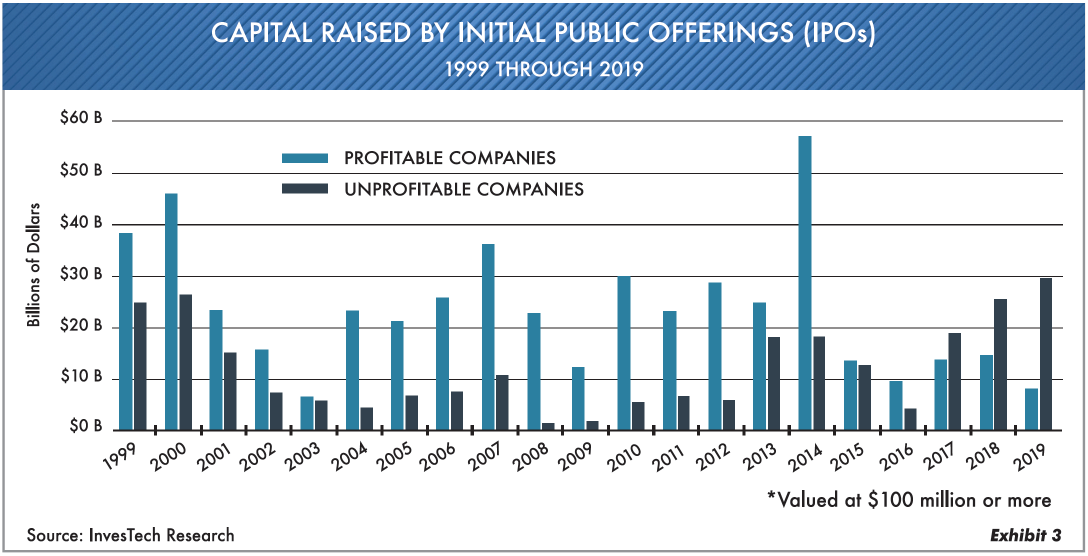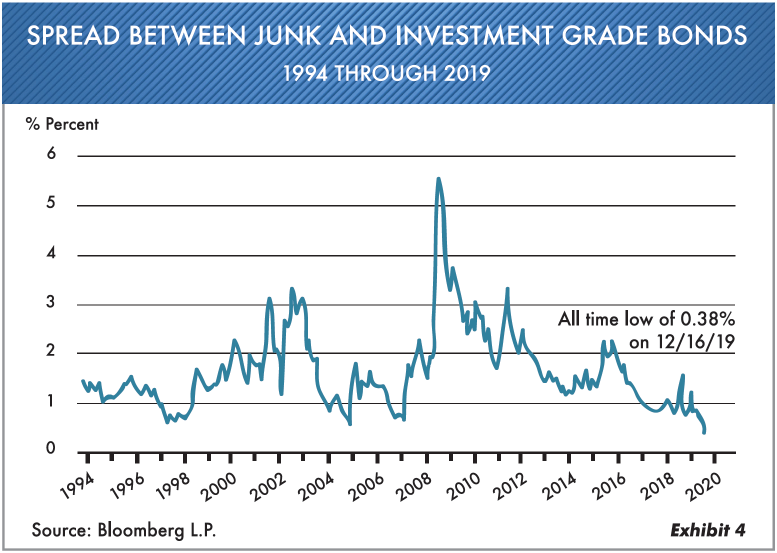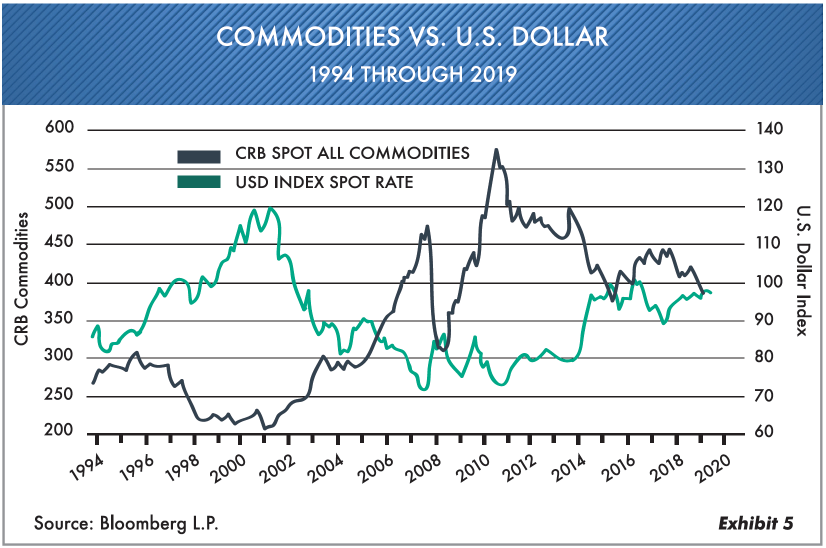Vision has always been measured by numbers such as 20/20, 20140 or 20/200. This helps identify the level of eyesight. Unfortunately, we in the investment world cannot quite achieve such clarity about the future. As the above title indicates, we also would like to be able to see more clearly what lies ahead. Most likely, though, 2020 will be a year of surprises for investors. In this “Market Comments,” we hope to provide some insight into a few of the possible maim issues.

Exhibit 1 shows returns of various popular market measurements for the year ending December 31, 2019.
There have been relatively few years in the past when both the stock market and the bond markets did well together. The year 2019 began with the Federal Reserve folding on previous promises to normalize interest rates when the stock market began falling in early December 2018. That started the money easing that pushed nearly all investments higher, including junk bonds. (This we’ll discuss later.) Meanwhile, global growth in 2019 weakened to its slowest pace in 10 years, but nonetheless, the markets went up. The Federal Reserve and the European Central Bank (ECB) got into the action as they opened the valves of liquidity by lowering interest rates.
The Rest of the Story
As noted, the stock market fell precipitously in December 2018, which set up the beginning of the big rally in 2019. At the same time, as we have repeatedly said, the bond market also moved higher. What the majority of the investing public fails to realize is how well fixed-income investments have performed over the past two years. U.S. Treasury bonds, for example, have actually outpaced the S&P 500 Composite in total return from January 26, 2018 (high), to December 20, 2019. This is shown in Exhibit 2.

Shades of 1999
In January 2000 our Market Comments highlighted 13 stocks that were incredibly overpriced. They were the “Darlings of Wall Street” at that time … Cisco Systems, General Electric, AT&T, Nortel, Oracle, Lucent Technology and Sun Microsystems, to name a few. Fourteen years later, none of them were higher in price, if even still in business. The norm now, as in 1999, is “Buy high, Sell higher.”
What Wall Street handed the public throughout 2019 with the majority of initial public offerings of common stock reminds us a lot of the market environment in late 1999 and early 2000. Notice in Exhibit 3 the increasingly high percentage of initial public companies that have negative earnings. In fact, during the last three years this has become the norm. For example, companies such as Peloton, Slack, Uber, Zoom, Pinterest and Lyft all lost money. Just start a company online, spend tons on advertising and go public with virtually no earnings. Bang … we are all billionaires! Perhaps the stumbling of the company We Work may cause even Wall Street to reach a choking point!

No Caution on Debt
In the past, investors at times bought all sorts of bonds that had little value. One of the areas now, for example, where we’ve seen the most speculation is in junk bonds. As the name implies, these are bonds with a poor credit rating, and many of them represent companies that are losing money.
Notice Exhibit 4 showing the yield spread between junk bonds and investment-grade bonds. What this tells us … is that investors are getting 0.38% more yield for junk bonds over investment-grade bonds. Think about how much common sense that makes. Very little. Investors have no idea what they’re investing in relative to quality and liquidity.

This is how it works. Managers of a bond fund will say they’re primarily investment grade, then throw in a percentage of junk paper to improve yields. In other words, the worst cannot possibly equal the best, but that’s what is happening. The reason for that is the length of the long-term economic cycle where very little is going bad yet. In reality, economic cycles still come and go just as seasons do. When the uptrend ends, investors will likely get a less appealing look at the junk-bond market.
Presently, you’ll see that most Oxbow portfolios hold either very high-grade municipal bonds or U.S. Treasury bonds. For now, we strongly believe that safety is the key. Liquidity in lower rated issues can quickly dry up. That is another reason for owning U.S. Treasury bonds. Interestingly, federal lawmakers just approved another $1.4 trillion in discretionary spending on top of the $23 trillion in debt the U.S. already has. Sad to say, for the last nine years or more both political parties caved in and have given little thought to borrowing levels.
Outlook for 2020
While at the beginning of 2019 we had expected some rebound to occur in stock prices, suffice it to say, we didn’t anticipate that much. We did think U.S. Treasury bonds would do well, and that has come to pass. Looking ahead, things that could throw investors off a little in 2020 would be the value of the dollar, plus energy and bond prices. Exhibit 5 shows the Commodity Research Bureau index and the U.S. dollar over the last 25 years.

As shown, the dollar has been weakening over the last few years as it has made a series of lower highs. It wouldn’t surprise us to see commodity prices drift higher as the dollar trends lower. This would have a great impact on higher energy prices. Notice that when the dollar is extremely high or low the commodity index tends to move in reverse. Energy and MLP (Master Limited Partnership) stocks at Oxbow had a subpar year in 2019, but in 2020 they could catch up. Our equity accounts enjoyed good performance in 2019 and on a risk-adjusted basis did very well. While some investors may think we’re out of the stock market, we are not.
We continue to be very particular about what we buy, which is why we have more liquidity than normal. Looking back, last year still reminds us of 1999. The theme then-and to a degree today by some investors-is to just keep buying and expect things to get more expensive. For a while it works.
On the bond side, our Oxbow portfolios still own short-term and long-term U.S. Treasury bonds, as well as high-grade municipal bonds. Last year these fixed-income portfolios had some of their best returns in a long time despite being very conservative. In 2020 we look for our income-managed accounts to have another good cash-flow year. As we said at the beginning of this issue of Market Comments, we wish our 2020 vision could be clearer. To compensate, however, we have built in some safety.
In closing, here are a couple of our favorite books to read during the new year.
1) Lifespan: Why We Age-and Why We Don’t Have To by David A. Sinclair. It’s a great read on food portions and the quantity of food we eat.
2) The Boy, the Mole, the Fox and the Horse by Charlie Mackesy. A great book recommended by Chance Finucane, our chief investment officer. We recommend purchasing the hardcover of this one for illustrative purposes. It’s a great book for both the very young and the very old … Uplifting.
As we move into the new decade, our goal is to be in front of changes. We want to thank you for your confidence in us. Be assured we will give it our best.
Ted Oakley
Bob Walsh
1-877-604-5707
Email: info@oxbowadv.com
Website: www.oxbowadvisors.com
